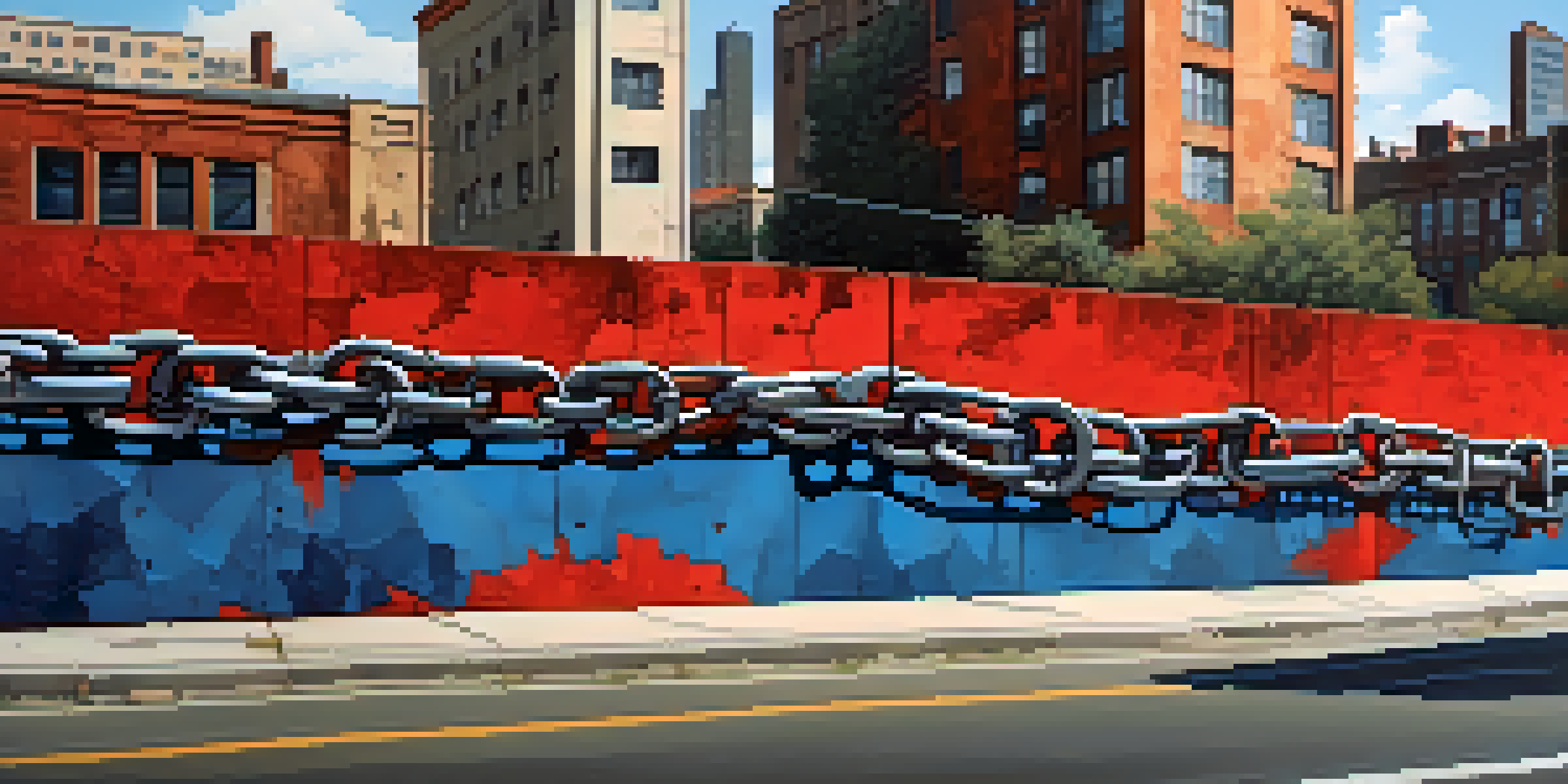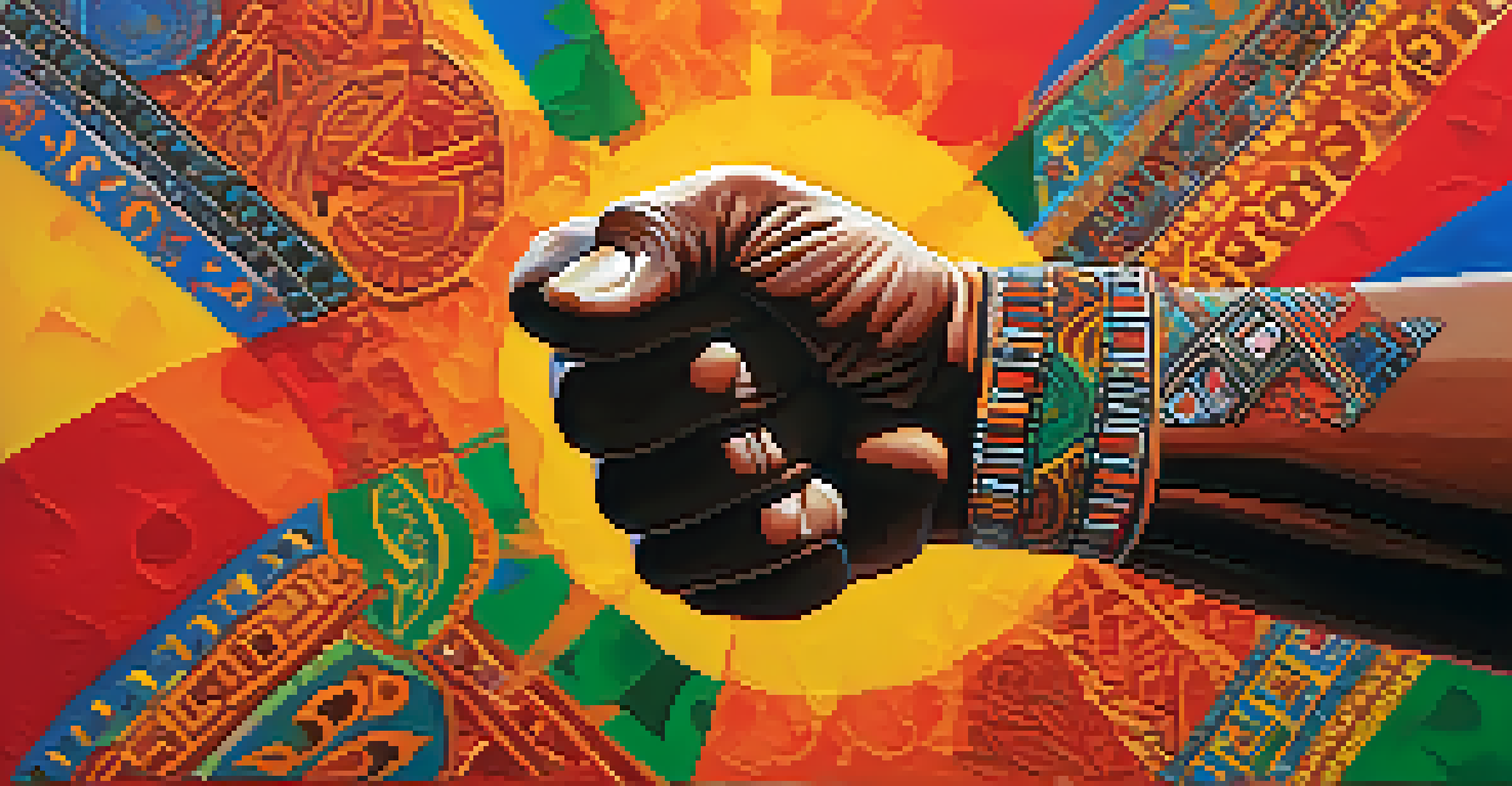How Artists Use Symbolism to Convey Political Messages

Understanding Symbolism in Art and Politics
Symbolism is a powerful tool in art, allowing artists to express complex ideas through simple images. By using symbols, artists can convey political messages without explicitly stating them, encouraging viewers to think critically about the underlying themes. For instance, a broken chain might symbolize the struggle for freedom, while a red rose can represent revolution. This layer of meaning adds depth to artwork, making it not just visually appealing but also intellectually engaging.
Art is not a mirror held up to reality, but a hammer with which to shape it.
The beauty of symbolism lies in its ability to transcend language barriers. A visual representation can evoke emotions and ideas that might be difficult to articulate in words. This makes it an effective means of communication in political discourse, where messages often need to be conveyed quickly and clearly. For example, during protests, artists might create murals that speak to issues like inequality or corruption without needing lengthy explanations.
Ultimately, symbolism serves as a bridge between the artist's intent and the audience's interpretation. It invites viewers to engage with the artwork on a personal level, encouraging them to draw their own conclusions about the political messages being conveyed. This dynamic interaction can spark conversations and inspire action, illustrating the profound impact of art in the political realm.
Historical Examples of Symbolism in Political Art
Throughout history, artists have utilized symbolism to comment on political issues. One famous example is Pablo Picasso's 'Guernica,' painted in response to the bombing of a Spanish town during the Spanish Civil War. The chaotic imagery and distorted figures symbolize the horrors of war, serving as a powerful anti-war statement that resonates even today. This painting demonstrates how art can capture the emotional weight of political events, creating a lasting impact.

Another significant example is the use of the peace sign, designed by Gerald Holtom in the 1950s. Originally created for the British nuclear disarmament movement, this simple symbol quickly became emblematic of the broader peace movement. Its widespread recognition illustrates how a single symbol can encapsulate a collective desire for change, making it an effective rallying point for political activism.
Symbolism Enhances Political Art
Artists use symbolism to convey complex political messages, inviting viewers to engage and reflect on deeper meanings.
These historical instances show that symbolism in art is not a new phenomenon; rather, it has been a vital part of political expression for centuries. Artists have long understood that a well-crafted symbol can convey a message more powerfully than words alone, allowing them to comment on the state of society and inspire future generations.
Modern Artists and Their Symbolic Messages
In today's world, many contemporary artists continue to leverage symbolism to address pressing political issues. Take, for instance, the work of Banksy, a street artist known for his provocative imagery. His pieces often incorporate familiar symbols, like rats or flowers, to comment on themes such as social inequality or environmental concerns. By using these symbols, Banksy invites viewers to question the status quo and consider the implications of their actions.
Symbols are the language of the soul, the silent words that we all understand.
Similarly, artists like Ai Weiwei utilize symbolism to highlight human rights violations. His installation, 'Sunflower Seeds,' features millions of handcrafted porcelain seeds, which can symbolize the mass production and loss of individuality in the face of oppressive regimes. This artwork encourages viewers to reflect on the balance between community and individuality, sparking dialogue about broader societal issues.
The ability of modern artists to innovate while using time-honored symbols demonstrates the adaptability of this technique. Through their work, they remind us that art continues to play an essential role in political discourse, challenging us to engage with the world around us in new and meaningful ways.
The Role of Social Media in Symbolic Art
In the digital age, social media has transformed how artists share their work and its political messages. Platforms like Instagram and Twitter allow artists to reach a global audience instantly, spreading their symbolic art far beyond local communities. This increased visibility can amplify the impact of their messages, as users share and reinterpret these symbols within their own contexts, creating a ripple effect.
For instance, the raised fist has become a widely recognized symbol of solidarity and resistance in various social movements. Artists and activists alike have used this image across social media to unite people around common causes, making it a powerful emblem of collective action. The ability to quickly disseminate and adapt these symbols makes social media a vital tool for political expression.
Historical Impact of Symbols
Throughout history, symbols like Picasso's 'Guernica' and the peace sign have played crucial roles in political expression and activism.
However, this rapid sharing also raises questions about the authenticity and ownership of symbols. As symbols travel across different cultures and contexts, their meanings can shift or become diluted. Artists must navigate this landscape carefully, ensuring their original intent is preserved while still engaging with a diverse audience.
Symbols of Resistance in Protest Art
Protest art often employs symbolism to communicate resistance and resilience. For example, the pink pussyhat became an iconic symbol during the Women's March in 2017, representing solidarity and a challenge to oppressive political structures. This simple yet powerful symbol helped unify thousands of participants, showing how art can be a catalyst for social change.
Similarly, the image of a raised fist has long been associated with various movements advocating for civil rights and social justice. Its symbolism transcends borders and time, representing defiance against oppression. Artists who incorporate this imagery into their work help keep the spirit of resistance alive, inspiring others to join the fight for equality.
These symbols not only provide a visual representation of protest but also foster a sense of community among those who resonate with the message. By rallying around these shared symbols, individuals can feel empowered to take action and make their voices heard in a world that often tries to silence dissent.
The Emotional Impact of Symbolism in Art
Symbolism in art has a unique ability to evoke emotions, making political messages more resonant. When viewers encounter a powerful symbol, it can trigger feelings of anger, hope, or solidarity, depending on the context. This emotional connection often encourages deeper reflection on the associated political issues, prompting individuals to engage with the artwork and its message on a personal level.
For instance, consider the use of the color red in political art. Red can symbolize passion, revolution, or even danger, depending on how it’s employed. An artist might use red to draw attention to an urgent issue, such as climate change, evoking a sense of urgency and need for action. This emotional response can be a driving force behind activism and social change.
Modern Art Meets Social Media
In the digital age, social media amplifies the reach of symbolic art, allowing for rapid sharing and adaptation of political messages.
By tapping into our emotions, artists can inspire viewers to not only contemplate political messages but to also feel compelled to act. This interplay between symbolism and emotion underscores the transformative potential of art, making it a vital component of political discourse.
The Future of Symbolism in Political Art
As societal issues evolve, so too will the symbols used in political art. Emerging artists are likely to create new symbols that reflect contemporary challenges, such as climate change, digital privacy, and social justice. By adapting symbolism to address these pressing issues, artists ensure that their work remains relevant and impactful.
Moreover, the integration of technology into art opens up new avenues for symbolism to thrive. Virtual reality, augmented reality, and interactive installations can enhance the experience of symbolic art, allowing audiences to engage with the messages in innovative ways. This evolution challenges artists to think creatively about how they can communicate their political ideas.

Ultimately, the future of symbolism in political art will depend on the artists' ability to listen to the world around them and respond meaningfully. By continuing to explore the rich potential of symbolism, artists can contribute to vital conversations about societal change, inspiring future generations to engage with art and politics in transformative ways.